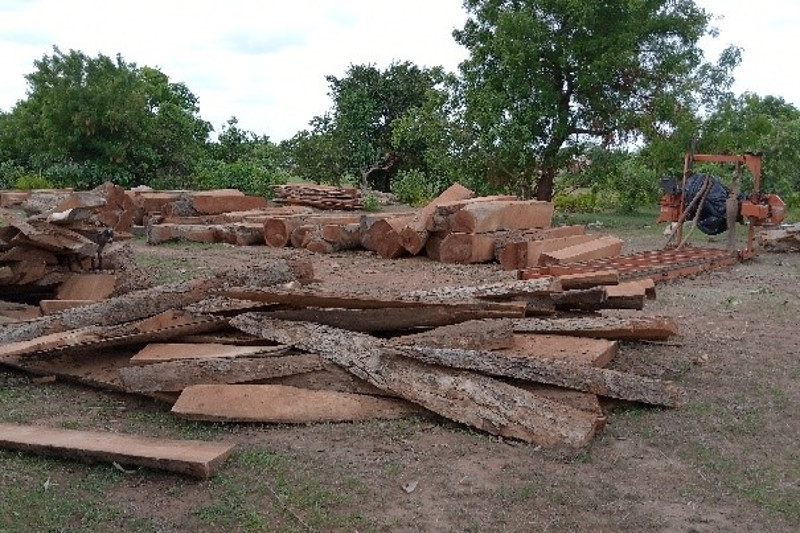By: Mathurin Zida, Eric Bayla and Houria Djoudi

Although COLANDS in Ghana resumed fieldwork in 2021, the team adopted a cautious approach, compatible with local COVID-19 pandemic restrictions, to minimize infection risk for the COLANDS team as well as communities and other stakeholders.
COLANDS team members David Atuobi, Eric Bayala and Mathurin Zida began meetings In January 2021 with key stakeholders at the local level (community and district) and regional level to introduce the COLANDS project and describe the integrated landscape approach (ILA) at the core of COLANDS work. Subsequently, Atuobi and Bayala contacted more stakeholders, including institutional actors, Community Resource Management Area (CREMA) leaders, local communities, civil society organizations, and the private sector. All stakeholders met by the team expressed interest and willingness to collaborate in COLANDS activities.
COLANDS efforts are being implemented at landscape level within the Western Wildlife Corridor (WWC) in Northern Ghana. More than 3,700 square km in size, the WWC stretches from the Mole National Park (MNP) in the country’s Savannah region to the Burkina Faso border in the north. There are six CREMAs within the WWC, covering a total area of approximately 600,000 ha. The CREMA model was established by Ghana’s government in the early 2000s, to try to preserve biodiversity by involving local communities in the protection and sustainable use of nature.
In the second phase of field work, the COLANDS team collected data through key informant interviews and focus group discussions, using Q-methodology to build a baseline about stakeholders’ roles in the landscape. The data collected related to landscape governance, perceptions of different stakeholders on landscape governance, multistakeholder platforms (MSPs), relationships and networks between actors, decision-making processes, and inclusion of stakeholders. This data made it possible to analyse common concerns that will serve as entry points for the negotiation and adoption of an Integrated Landscape Approach (ILA) within the WWC.
A total of 34 focus groups were conducted and after a preliminary analysis of the data, three MSP workshops were organized, using the research results to discuss desired changes in the landscape in terms of biodiversity conservation and livelihoods with various stakeholders.
The COLANDS team is also analysing MSPs and local organizations within the WWC to assess the best institutional arrangement for adopting landscape approaches. Based on informal surveys and analysis of relevant documents, existing MSPs and local organizations within the WWC were identified. The team then designed a questionnaire aligned with the ten principles of the landscape approach (LA) to further analyse how these MSPs and local organizations can be harnessed to strengthen the negotiation of the LA in the WWC landscape. The draft questionnaire has been further developed, based on several rounds of comments and inputs. However, due to COVID-19 issues affecting project staff, the study was delayed and is now targeted for resumption in February 2022.
Biodiversity Research
COLANDS in Ghana has partnered with the Department of Forestry & Forest Resources Management from Ghana’s University for Development Studies (UDS) to implement the biodiversity component of COLANDS. The UDS assignment includes:
• Biodiversity-related data gap analysis in the WWC, based on a literature review;
• Remote sensing study on Land Use and Land Cover Changes (LULCC) in the target CREMAs within the WWC;
• Analysis of landscape fragmentation and connectivity;
• Ground survey, sampling protocol for vegetation (trees or more plant group), birds and arthrop
UDS has reviewed the biodiversity-related literature in the WWC and is currently carrying out the LULCC study. A draft report from one CREMA (Sanyiga Kasena Gavara Kara – SKGK) has been produced for COLANDS team comments and inputs. Based on that, UDS will continue the study for the remaining CREMAs.
Research in shea parklands
The team has also begun to analyse community-based conservation strategies with a focus on shea parklands to better understand the agroforestry systems in the landscape. Specifically, the study involves:
• Assessing tree diversity and abundance in parklands within four communities (Weisi, Baasa, Vundema and Kasiesa) in the Builsa South District of Ghana’s Upper East Region;
• Analysing the perceptions of changes in tree conditions and associated goods and services within parklands and how this affects people’s livelihoods;
• Identifying challenges to parkland restoration and documenting existing local conservation/restoration practices.
Qualitative data were collected using questionnaires and an interview guide, with a total of 200 (50 per community) questionnaires administered among household heads. The questionnaire gathered data ranging from the respondent’s socio-demographic characteristics, perceptions of changes in tree conditions in parklands, the goods and services people derive from the parklands and impacts on their livelihoods, as well as parkland restoration practices in the communities and associated challenges. Focus group discussions were held in each participating community, with five men (including older farmers/hunters), five women (also including older farmers), five male youths, five female youths and three community leaders (assemblymen/woman and CREMA executives).
The COLANDS Ghana team supported a Ghanaian MSc student, Arimiyaw Abdul Wahid, from the University Felix Houphouet-Boigny (UFHB) in Cote d’Ivoire, to design and carry out this study. He successfully defended his MSc thesis “Assessing community-based biodiversity conservation strategies of parklands and its impact on household livelihood in the savannah zone of Ghana”. Some of this research is being published by the PhD and MSc students working with COLANDS in Ghana. The data is now being analysed with results expected in time to be reported in the next COLANDS newsletter.




